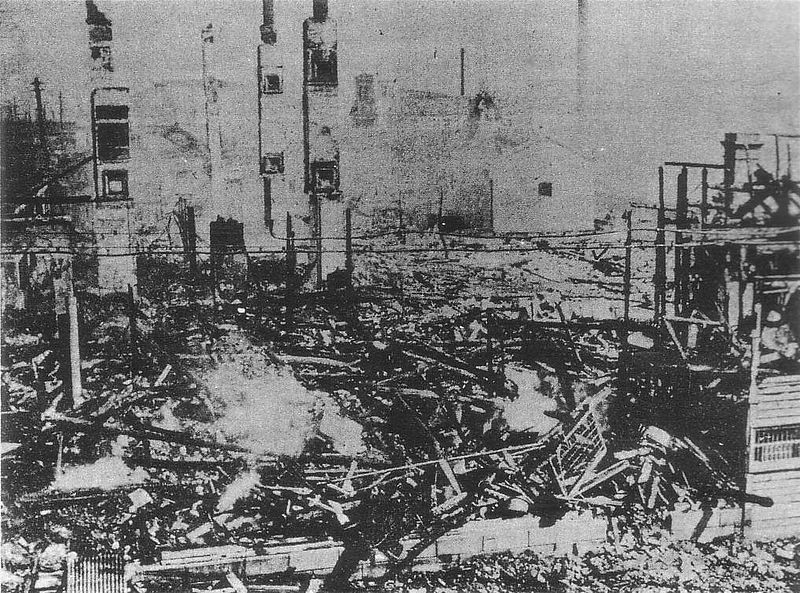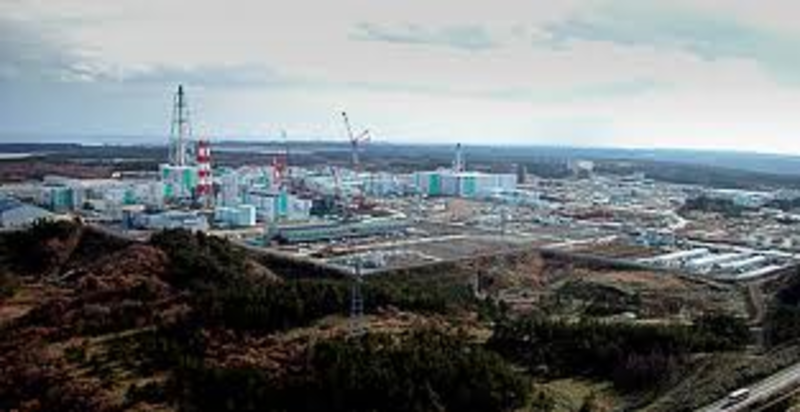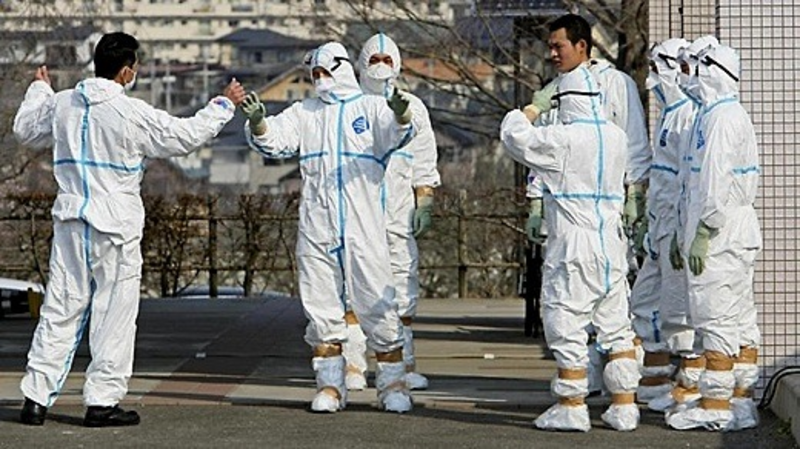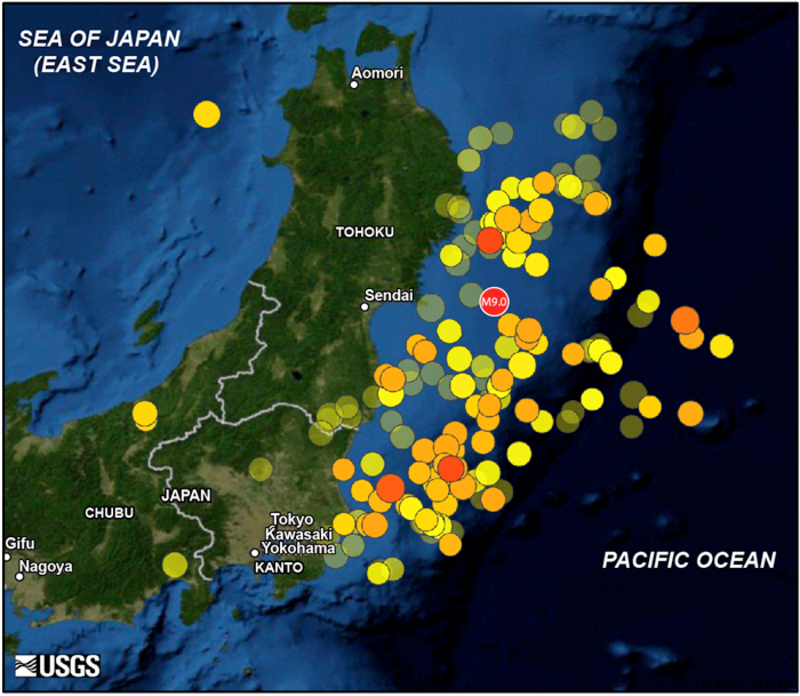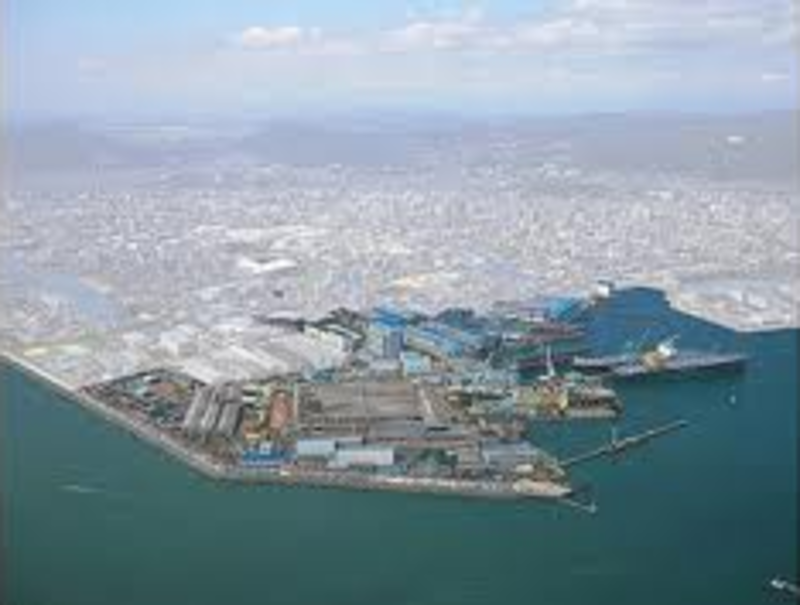The Hidden Face of Disaster: 3.11, the Historical Structure and Future of Japan’s Northeast
Oguma Eiji
Translated by Kyoko Selden
The original Japanese text is available here.
A Provider of Food
It is not well-known that the Tōhoku region only established its position as the nation’s rice production center after World War II. Yields of rice, a commercial crop of tropical origin, were relatively low in the Northeast until the Taishō Era (1912-1926).
Rice production in the region, however, started growing partly due to advances in agricultural technology and partly due to a variety of economic and political factors. The factors included the expansion of Tokyo as the nation’s principal consumer market, government efforts to increase food production during and after the war, and the postwar independence of colonial Korea and Taiwan, which supplied Japan’s rice before the war. As a result, Tōhoku became a major supplier of rice, vegetables and seafood for Tokyo.
Especially significant was the food control system introduced in 1942 on a total war footing for the purpose of stable rationing. This system, in which the government purchased rice and other products at fixed prices and supplied consumers with food, stabilized the price of rice, which had been a crucial issue for prewar Japan.
Before the war, fluctuations in the price of rice caused hardship in Tōhoku. In 1918, in response to a precipitous rise in the price of rice, large-scale disturbances known as “Rice Riots” erupted throughout the country.
|
Suzuki Shoten burned during 1918 riots |
The government implemented policies to increase rice production in Korea and elsewhere, but this resulted in overproduction. The price of rice plummeted after the Great Panic of 1929, and Tōhoku fell into a serious economic crisis. Memories of selling daughters into bondage as prostitutes, widely practiced in Tohoku during this period, have been handed down to this date.
The food control system, which was carried into the postwar era, stimulated cultivators to produce rice. Even then, progress in rice production in Tōhoku was not so rapid. Yamagata prefecture’s crop, making a “leap” to third place in the entire country around 1950, is said to have marked the beginning, but the crop in prefectures like Iwate and Miyagi was below the national average. It was only in 1990 that Akita, Yamagata, and Aomori occupied the top three places, with Iwate, Fukushima, and Miyagi ranking among the top ten.
|
Rice fields, Miyagi |
Viewed nationally, as the taste of the urban population turned toward luxury food, demand for rice fell around 1966 when Japan achieved rice self-sufficiency. In the prewar free market system, this would have incurred a sudden fall in the price of rice. The government, which was operating price controls under the food control system, enforced an acreage reduction policy starting in 1970. In this way, the government took the leadership in determining the acreage of rice cultivation.
Thus, the history of Tōhoku’s rice production traces the process in which cultivators try to respond to national policies and Tokyo’s demand. However, the moment they do respond, decline in demand begins and, along with it, reduction of acreage. Nevertheless, Tōhoku’s position as a rice producer rose. This is sometimes said to be the result of Tōhoku, with its poor climate conditions, sticking to production of rice whose price was politically stabilized, whereas warm regions including western Japan abandoned rice, now lower in demand, for farm products with higher added value.
A Hub of Small Manufacturers of Parts
Tōhoku was also a source of cheap labor for the nation’s capital. During the era of rapid economic growth, companies in Tokyo employed legions of junior and senior high school graduates as well as migrant workers from the region. To this day, the outflow of young workers is striking. In addition, a large pool of low-wage, non-regular workers, mainly women in rural areas without much education, turned the region into a manufacturing hub by attracting subcontractors, such as parts suppliers.
Japan’s auto and electricity industries grew rapidly in the 1960s and established factories in rural areas like Tōhoku in order to cope with labor shortages. Those who learned skills in urban factories also returned to their home villages and started small factories for producing parts as subcontractors or sub-subcontractors.
In a small factory of several to a dozen employees, most are part-time workers like farm wives over age forty and the manager’s family members. Because they are regarded as half-wage earners who work to supplement the family income, their pay is often barely above the legal minimum wage of several hundred yen per hour, even for those who have skills equaling those of skilled workers. They don’t hunt for jobs when they are laid off during recessions, which means that they are not counted among the unemployed in the Japanese government’s official statistics. That they remain at home ready to be re-employed with economy recovery makes employment adjustment easy and costless.
Following the 1960s, sideline businesses rapidly expanded in Tōhoku’s farming and fishing areas. The majority of farms started businesses on the side without leaving the land, sending out some family members to Tokyo while the rest stayed home to look for work within commuting distance even though wage and other conditions were poor.
In typical cases, a family consisted of elderly members operating the farm, the housewife working at a local factory like those described above, with other family members working in Tokyo or for a local construction business, and with some holding jobs in the public sector, for example the town office or agricultural cooperative. As a result, the total family income was enhanced in its own way, even comparing favorably with that of an urban household typically comprised of a company employee and a stay-at-home wife, but this was owing to the labor of an entire family.
One student I taught was from a small farming village in Tōhoku, which lost half of its population to the 3.11 earthquake. Her family combined farming and manufacture of parts. She worked at the town office after graduation from high school. She left the village to study at a Tokyo university, but had she remained home, she would have quit her job at the town office after marriage and childbirth, and become a family employee of her parents’ factory once she was more or less through with child raising.
Tōhoku and Nuclear Plants
Tōhoku also became an important supplier of electricity for Tokyo. This history goes back to the 1930s.
The price of rice fell in the early 1930s, and damage from cold weather ensued, leading to a serious economic crisis in Tōhoku. In response, certain businesses began to promote Tōhoku. For example, the Tōhoku Promotion Electric Power Company (today’s Tōhoku Electric Power Co., or Tohoku-epco), was established in 1936. This company constructed a hydro power plant with a 680-kilometer system of transmission connecting Lake Towada and the areas of operation by the Tokyo Electric Light Company (now Tokyo Electric Power Company, TEPCO), thus sending electric power to Tokyo. Local electric power demand in Tōhoku was moderate. Reportedly one third of the electric power generated by the Tōhoku power station was sent to large-scale factories in the area, while two-thirds was sent to Tokyo.
Paralleling this, as a national total war system was constructed during the protracted Sino-Japanese war, electric power, like rice, was placed under state control as a critical industry. Electric power in the past, again like rice, had been left for the market economy to handle, and in 1932 the number of electric power companies had reached 816. However, in order to provide war industries with a stable supply of electric power, Japan Electric Power Generation and Transmission Company (Nihon Sōhatsuden Kabushiki-gaisha, also known as Nihon Hassoden K.K. in English) was launched in 1939 to monopolize power transmission, and in 1942, 152 electric power distribution sources throughout Japan were amalgamated into nine companies.
After the war the Japan Electric Power Generation and Transmission Company was divided and absorbed by the nine electric power companies, resulting in the present structure. The current Japanese power generation and especially distribution constitute the regional monopoly system of these nine electric power companies. While promoting nuclear power generation as national policy, the system prevents rising natural energy electric power generators from entry to the market. This structure is a legacy of the total war.
After the war, following the Comprehensive Land Development Law of 1950 and the Electric Power Development and Promotion Law of 1952, the electric power companies with regional monopoly cooperated with national policies to promote development of giant regional electric power sources. When selection of locations for nuclear power complexes began in the 1960s, places chosen from Tōhoku were Fukushima prefecture’s coastal zone, which was poor enough to be called “Fukushima’s Tibet,” and Aomori prefecture’s Rokkasho, which was a postwar settlement for repatriates from Manchuria. They had migrated to Manchuria in the period of economic crises in the 1930’s under government policies which promoted the transfer of Japanese farmers to colonies and occupied areas.
|
Rokkasho nuclear reprocessing plant |
In the case of Rokkasho, the Mutsu-Ogawara area was designated as a location for a large-scale industrial development project in the New National Comprehensive Development Plan of 1969; but Rokkasho failed to attract enterprises, and the land purchased for development remained unsold. In eastern Fukushima, the Jōban Coalfield, a neighboring industry, rapidly declined because of the change in energy sources after its coal output peaked in 1951. This historical background is connected to inviting a nuclear complex to these areas.
Nuclear Power Generation and Nuclear Development
Diverse arguments address nuclear power generation, but I would like to add from a historical perspective that it would not have developed without government participation derived from security policy.
The American light-water reactor that Japan introduced is a conversion from the nuclear submarine engine. The Russian-type graphite moderated reactor is a conversion from a plutonium reactor for manufacturing nuclear weapons. Many of the countries that produced nuclear power plants by the 1960s, such as the U.S., Britain, the Soviet Union, France, and China are nuclear-armed countries, a group that comprises the permanent members of the U.N. Security Council at. Even if expectations for the “energy of dreams” may have existed, it is doubtful, unless there was the aspect of producing it as a byproduct of nuclear armament, that those governments would have supported the development of nuclear power electric generation in those days, when it was hardly cost-friendly.
In Japan’s case, it is known that Prime Ministers like Hatoyama Ichirō, Kishi Nobusuke, and Ikeda Hayato made remarks that did not deny the possibility of nuclear armament. Especially after China conducted a successful nuclear test in 1964, Satō Eisaku, as is evident from American archives, repeatedly spoke positively about nuclear armament during U.S.-Japan negotiations. Even after the NPT (Nuclear Non-Proliferation Treaty) started under the leadership of the U.S. and the Soviets, the Japanese government demonstrated resistance for the reason that “as a result of participating in the NPT, it would be unbearable to be permanently ranked internationally as a second-class state.”
In 1970 the Japanese government signed the NPT (ratification in 1976), which became a factor in Satō Eisaku’s winning of a Nobel Peace Prize in 1974. However, a 1969 document of the Ministry of Foreign Affairs clarifies that Japan “adopts a policy of not owning nuclear weapons for now, but always maintains the economic and technological potential for manufacturing nuclear weapons.” At the time of the Diet resolution on the Three Non-Nuclear Principles, Satō withheld consent unless the measure was paired with “promotion of the peaceful use of nuclear energy.” This was the period when the prototype of Japan’s nuclear power policies were constructed, including selection of the locations for the current nuclear power plants and nuclear fuel cycle industry for extracting plutonium that can be used for nuclear weapons. Fukushima Daiichi started operating in 1971.
Even so, in 1973, nuclear power constituted 0.6 percent of Japan’s energy supply, accounting for just 3 percent of electricity generation. Reflecting the social situation with frequent cases of environmental pollution, it had become difficult to gain agreement from the localities designated for nuclear complexes.
However, the oil shock of 1973 proved to be another “security” bonanza for promoting nuclear power in place of development of nuclear weapons. The cliché that has traumatized Japan’s political leaders since the Pacific war resurfaced: “Japan is a country without resources.” It is still used today to promote nuclear power.
In response to the oil shock, three laws on electric sources were established in 1974 under the cabinet of Tanaka Kakuei, the embodiment of profit-inducing politics. The laws were created subsidies for inviting nuclear power generation by raising electricity prices. Here emerged the interface between national policy of the security treaty in a broad sense and regional interests in areas where high-speed growth was pushing depopulation, and local resistance against nuclear power generation weakened. Under the regional monopoly system of the nine electric power companies, it was easy to raise electricity rates, and, given their cooperative relationship with the government since the total war structure and huge capital investment, the electric companies began constructing nuclear power plants.
Starting in the late high-speed growth period, when acreage-reduction was adopted and depopulation progressed, nuclear power generation and grants-in-aid came to Tōhoku. Just as U.S. bases concentrated on Okinawa, Fukushima and Fukui became the centers of nuclear electric power generation that supplied Tokyo and Osaka with electric power. There, local people without other means of production worked. Because those manufacturing nuclear power were big metropolitan businesses, despite the fact that local economic effects were minimal, employment and subsidies were indispensible. Thus, nuclear power generation concentrated in grain-producing regions.
That subcontracted workers at nuclear power complexes are gathered from the lowest levels of Japanese society became widely known after the Fukushima Daiichi disaster. It has been reported that until the 1980s, homeless people were, and now insolvent debtors are, subcontracted in large numbers through yakuza. Earlier, Bahamian and Puerto Rican workers, brought by GM that built Fukushima Daiichi, were apparently often seen.
|
Workers at Fukushima Daiichi |
The National Land Formation Plan, ratified by the cabinet in 2008, says: “Large cities and rural areas are mutually dependent in that the former lead the latter as headquarters providing urban functions, economic activities, and international exchanges, while the latter supply the former with personnel, food, water, energy, and so forth.” The position given to an area like Tōhoku is that of a supplier of food, work force, and electricity. Or, like Okinawa, it can host U.S. air bases. Such a structure can be said to have emerged out of the domestic division of labor in an era marked by total war and high-speed economic growth from the 1930s to the early 70s.
Globalization and economic structural change in Tōhoku
With globalization from the 1990s, Tōhoku, as a supplier of primary produce and work force, was exposed to competition from other parts of Asia.
Industrial control policies promoted by the government, which emerged out of the total war system, and which functioned effectively in their own way in the high-speed economic growth period, also confronted the waves of open markets. As the economy slumped and tax revenues plummeted, the redistribution system, accompanied by distributing subsidies and public enterprises to localities, was criticized as a source of corruption and cozy relationships, and gradually became the target of structural reforms. The reversal of the industrial structure, as in the decline of manufacturing industry and its movement abroad, began to occur in Japan, taking place somewhat behind the West.
At parts manufacturers that remained in Tōhoku, real wages continued to fall because of cost competition with developing countries. To refer again to the student’s family business discussed above, the parent enterprise of their factory announced plans to shift its supply route to Peru. The plan was cancelled, however, and the family was able to continue to supply parts by lowering subcontract costs. Hourly payment for workers fell to 300 yen, below the legal minimum wage. Obviously this is illegal, but women workers cannot appeal to the labor standards office because they wish to maintain the factory and jobs.
The results for Japan are further depopulation and an aging society, along with over-concentration in Tokyo. Tōhoku is one of the areas where this phenomenon is particularly apparent.
The “Estimated 2030 Economic Scale” published in 2005 by the rural economy study group of the Ministry of Economy, Trade and Industry (METI), predicts that the population of Kamaishi city will decrease by 30.6 percent and the total production in the area by 25.7 percent by 2030. For Miyako city and Kesen’numa city, the decline in population is estimated at 24.9 percent and the total production at 15 percent. With Japan’s total population expected to decrease, Tokyo’s population increase during the same period is estimated at 0.8 percent, and its total production increase at 10.7 percent. In fact, Kamaishi, whose steel manufacturing peaked during the high-speed growth period, lost 52 percent of its population between 1965 and 2010.
 |
What proceeded in parallel starting in the 90s is the decline of small shops caused by the introduction of free markets and revisions of the large retailers law (Large-Scale Retail Stores Law, implemented in 1974), which reflected American demands for open markets and structural adjustments. Retail stores in Japan as a whole decreased from 1,610,000 in 1991 to 1,140,000 in 2007.
In rural areas, the decline in public transportation came to require cars even when shopping for basic necessities in small communities. Thus, gasoline stations became the lifeline of localities, but even they are decreasing because of financial difficulties from depopulation as well as lack of successors as communities age. The number of gasoline stations in Japan, which peaked at 60,421 in 1994, fell to 40,457 in 2009.
Depending upon localities, joint investment has become necessary to maintain gasoline stations. In Shichikashuku-machi in a mountainous area of Miyagi prefecture, one of the two gasoline stations closed in April 2010 due to financial difficulties and the owner’s age. But, depending upon household location, some households need to travel over a dozen kilometers to get daily necessities, so the closing was regarded as a serious problem. The chamber of commerce tried in vain to find someone to take over the business. In the end, the town contributed subsidies and rented it gratis from the owner, who contributed the lot and equipment. A local auto repair company then reopened the operation.
Difficulties of Reconstruction
The earthquake occurred under these historical circumstances.
|
Map shows earthquakes and aftershocks following March 1, 2011 |
The disaster combined the nuclear power plant accident and electric power crisis, contamination of agricultural and fishing products, shortage of gasoline and problems of physical distribution, large numbers of aged victims, breaks in the supply network due to stricken factories producing parts, and so forth. Given Tōhoku’s position in Japan and the processes underway since the 90s, this outcome was inevitable. If the Tokyo media discuss this as if it were an unanticipated compound disaster, “beyond assumptions,” that can only be attributed to the limitations of unconscious Tokyo centrism among those who only anticipated urban disasters like the Kanto and Hanshin earthquakes.
Conditions for reconstruction in Tōhoku also differ from those of the Kanto and Hanshin earthquakes. Unlike restoration in consumer cities, a producer region suffers limitations of city planning and counter-disaster measures. Kōbe, adjacent to Osaka, had access to employment, and temporary relocation of economic activities was also possible. This time, however, a depopulated region that anticipated losing one-third of its population by 2030 lost the basis of livelihood.
I don’t wish to sound discouraging about reconstruction, but I worry about further depopulation. For global capital and global cities, the supplier of food and work force does not have to be Tōhoku. The region, whose position was defined in the twentieth century national division of labor, received a blow amidst international division of labor competition in the twenty-first century. A trend to move factories overseas from Tōhoku with its earthquake and electric power supply risks is anticipated. Having lost entire towns and been exposed to radioactivity, if the situation of no prospect of work and safety continues, people will leave Tōhoku, young people first. Unless we squarely face this reality and involve Tokyo in sharing the will to change Japan’s structure and Tōhoku’s position in it, concepts of disaster-protected cities and eco-towns may end in newly built, yet depopulated, areas and financial deficits. Nor will we be able to create regional communities that do not depend upon nuclear power generation.
Intending to restore the old industrial structure by depending upon the introduction of public enterprises not only lacks prospects, but is ineffective in terms of reconstruction. Of the approximately 7.7 trillion yen ($100 billion at current exchange rates) reconstruction cost for bridges and roads invested in the damaged areas in the five years following the Hanshin earthquake, roughly ninety percent is estimated to have flown outside the stricken areas. Major general contractors with their main office in Tokyo and Osaka apparently contracted the majority of the reconstruction and repair work, with the majority of the reconstruction cost returning to city banks via those general contractors.
The main industries in Kōbe were solid, large industries and harbor businesses like Kawasaki heavy industry, Mitsubishi Heavy Industries’ Kōbe Shipyard, and Kōbe Steel Manufacturing, followed by local light industries like producers of chemical shoes. The earthquake occurred while solid, large industries were hollowing out because of changes in industrial structure and competition with Asia that began in the 1990s. Many of those industries did not return to Kōbe, the harbor was defeated in the competition with Pusan, and the chemical shoes failed to win over Chinese products. The earthquake and industrial stagnation restrained purchasing, reconstruction money flowed outside the stricken area, and commerce stagnated. Setting Japan’s GDP and the gross product of the disaster Hanshin area in 1993 each at 100, as of 2003 Japan’s GDP was 105 and that of the disaster area was 88.
|
Mitsubishi Heavy Industries at Kōbe Harbor |
The industrial structure of Kōbe around 1995, centering on ship building, steel manufacturing, and harbor business was the product of twentieth century Japan’s industrial mapping, as was Tōhoku’s rice production, parts manufacturing, and Kamaishi’s steel manufacturing. When an area that has been hollowing out amid changes in industrial structure and international competition receives a blow from an earthquake, the slump of existing industries already underway is suddenly accelerated. The Kōbe economic slump was a result of this phenomenon.
Even so, as stated above, employment was available and temporary relocation of economic activities was possible in the case of Kōbe as Osaka’s neighboring city. Hyōgo prefecture was also then one of the population-increasing prefectures—the number of such prefectures was dwindling from the 1990s—reconstruction of its streets proceeded in its own way. However, because of the above-mentioned factors, post-earthquake Kōbe is sometimes described as having turned into Osaka’s bed town with declining industry. The conditions in damaged Tōhoku areas are even more severe.
Breaking away from Wartime
A prerequisite for the region’s recovery and reconstruction is a big-picture plan for bringing the nuclear crisis under control. The challenge requires at least several months to cool the reactors, a challenging endeavor that entails the risk of radioactive leaks. The amount of radiation escaping from the plant has declined since March, but the danger of a fresh massive release remains. The government should now go beyond using a random collection of inconsistent stopgap measures to cope with the crisis (the government-set upper limit of radiation levels for drinking water is seven times higher than that for waste water discharged by a nuclear power plant). Instead, it should map out and announce a convincing long-term strategy that takes into account all possibilities, including further expansion of the evacuation zone and various economic and international consequences. If people suddenly face a nuclear emergency without being informed of the risk in advance, they are more likely to panic. Nobody in the world wishes to hear the words “unanticipated.”
Nuclear energy is not only a typical super-scale industry that has passed its peak, it is also a technology with risks that are excessive. There seems no choice but to phase it out. Nuclear power generation is said to be more expensive even now than natural gas. If safety hurdles rise in the future, it will become even more costly. If disposal of radioactive waste material and compensation for accidents are added, it can hardly be economically manageable.
According to a July public opinion poll, support for phasing out nuclear power generation in Japan reached 77 percent. International opinion poll surveys in response to Fukushima demonstrate that Japan, Germany, and Italy indicate a preference for breaking away from nuclear power generation, while the U.S., France, Russia, China and others adhere to their standpoint of nuclear power promotion. In other words, the standing members of the UN Security Council, who armed themselves with nuclear weapons after winning World War II maintain their position of promoting nuclear power generation, while the countries that lost the war and were unable to have their own nuclear development technology wish to break away from nuclear power generation. This reveals the fact that nuclear power is a relic of twentieth century warfare.
Right after the earthquake, Prime Minister Kan Naoto stormed directly into TEPCO, which was encouraging evacuation from the site of the disaster, and in May stopped the Hamaoka nuclear plant by means of a “Prime Minister’s request.” These are extra-legal actions with no legal basis. If he were to follow formal legal procedures, he would have consulted the Minister of Economy, Trade and Industry, and the Minister would have worked on the Ministry, the Ministry on the Nuclear and Industrial Safety Agency, and NISA on the electric companies. Had Kan followed these steps, the accident might have been followed by a greater catastrophe, and the stopping of the Hamaoka plant would not have been possible. This recent state of affairs demonstrates that nuclear energy requires extra-legal power for handling accidents and prevention measures.
The expression, “Nuclear power generation and democracy are incompatible,” reflects the background of inviting profit to the area, concealment of information, and suppression of those opposed to the policy. However, nuclear power generation, which is a byproduct of nuclear weapons to start with, is not compatible with democracy even at the level of handling accidents and stopping operations because of dangers and costs. To carry the point further, it is beyond the ability of a modern constitutional government.
The same is demonstrated by the fact that the use of atomic energy was possible from the start only under the control of international organizations like IAEA, that it was promoted under government leadership with national security in mind, and that the management of the Chernobyl accident was only possible under the Soviet system. Martin Jänicke, formerly of Berlin Free University, says, “In democratic society, areas with a perfectly liberalized electric power market have no option for new construction of nuclear electric power plants.” It is safe to say that nuclear power generation was an industry made possible only under state power that was inflated through the total war known as World War II.
The system of postwar Japan, which achieved economic growth under government guidance, control and protection is, as often pointed out, an extension of the structure whose foundation was built under the total war system. The food control system that encouraged increased rice production in Tōhoku and the regional monopoly system of electric power companies that promoted nuclear power generation is a model of that structure. It was also a relic of the war age called the twentieth century symbolized by two all-out wars and the cold war. The Japanese economic slump, and the sense of stagnation since the 1990s, indicates the deadlock of such a structure.
What was concentrated in Tōhoku, be it rice or Kamaishi’s steel manufacturing, is industry of the past that peaked between the 1960s and 80s. Nuclear power generation is no more than a model of that. In post-earthquake reconstruction, for Tōhoku to revive the industrial structure designated by the past Japanese society neither offers any prospect nor is realistic. For Japanese society as an entirety to take the direction to convert to natural energy and positively promote natural energy-based new industry, will be one plan for reconstruction of Tōhoku. The report presented by the government’s council on reconstruction plans is chaotic, representing views of various circles. But it also introduces a concept of designating Fukushima as a natural energy area. It is hoped that efforts will be taken in that direction.
In the wake of the calamity, the phrase “Ganbare Nippon” (Hang in there, Japan) has become a popular mantra. The Great East Japan Earthquake, however, has made it painfully clear that the regional gaps have become so wide in modern Japan that we cannot bring the regions together and generalize them as Nippon.
What is in question is the ability of Japanese society to break away from the socio-economic structure constructed in the twentieth century, including its ”successes”, and to conceptualize the future, Without that, neither Tōhoku’s regeneration nor Japan’s future can be secured.
This is a revised and expanded version of an article that appeared in The Asahi Shimbun on June 8, 2011 under the title “Disaster highlights Tohoku’s unique structural weaknesses.”
Oguma Eiji is professor of Policy Management, Keio University and an historical sociologist. His book, A Genealogy of ‘Japanese’ Self-Images is a translation of Tan’itsu minzoku shinwa no kigen (The origin of the myth of Japanese as a homogeneous ethnic group), which won the Suntory Culture Award. He is coeditor with Kang Sangjung of Zainichi issei no kioku (Memories of the First Generation of Koreans in Japan) 在日一世の記憶 / 小熊英二, 姜尚中編.
Kyoko Selden is a translator and editor who taught Japanese language and literature at Cornell University. Her translations include Kayano Shigeru’s Our Land Was a Forest, Honda Katsuichi’s Harukor: Ainu Woman’s Tale, The Atomic Bomb: Voices From Hiroshima and Nagasaki, and most recently, More Stories By Japanese Women Writers, An Anthology. She is an Asia-Pacific Journal associate.
Recommended citation: Oguma Eiji, “The Hidden Face of Disaster: 3.11, the Historical Structure and Future of Japan’s Northeast,” The Asia-Pacific Journal Vol 9, Issue 31 No 6, August 1, 2011.
Articles on related subjects
• Cara O’Connell, Health and Safety Considerations: Fukushima Nuclear Power Plant Workers at Risk of Heat-Related Illnesses
• Chris Busby, Norimatsu Satoko and Narusawa Muneo, Fukushima is Worse than Chernobyl – on Global Contamination
• Robert Jacobs, Social Fallout: Marginalization After the Fukushima Nuclear Meltdown
• Say-Peace Project and Norimatsu Satoko, Protecting Children Against Radiation: Japanese Citizens Take Radiation Protection into Their Own Hands
• Sakai Yasuyuki, Japan’s Decline as a Robotics Superpower: Lessons From Fukushima
• Lori Dengler and Gregory Smits, The Past Matters: Lessons From History and From Japan’s March 11 Earthquake and Tsunami
• Matthew Penney and Mark Selden, What Price the Fukushima Meltdown? Comparing Chernobyl and Fukushima
• Hirose Takashi, The Nuclear Disaster That Could Destroy Japan – On the danger of a killer earthquake in the Japanese archipelago
• Gregory Smits, Danger in the Lowground: Historical Context for the March 11, 2011 Tohoku Earthquake and Tsunami
• Christine Marran, Contamination: From Minamata to Fukushima
• Paul Jobin, Dying for TEPCO? Fukushima’s Nuclear Contract Workers
• Andrew DeWit and Sven Saaler, Political and Policy Repercussions of Japan’s Nuclear and Natural Disasters in Germany
• Makiko SEGAWA, Fukushima Residents Seek Answers Amid Mixed Signals From Media, TEPCO and Government. Report from the radiation exclusion zone
• Kaneko Masaru, The Plan to Rebuild Japan: When You Can’t Go Back, You Move Forward. Outline of an Environmental Sound Energy Policy



